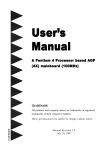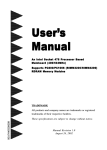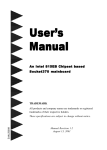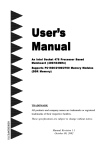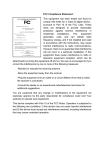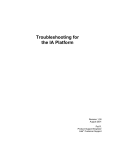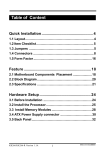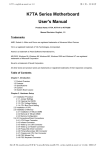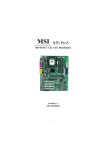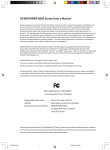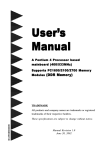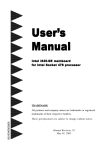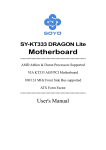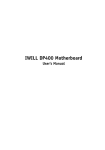Download User's Manual
Transcript
User’s
Manual
A P
entium 4 Pr
ocessor based AGP
Pentium
Processor
(4X) mainboar
d (100MHz)
mainboard
TRADEMARK
All products and company names are trademarks or registered
trademarks of their respective holders.
These specifications are subject to change without notice.
600024T12
Manual Revision 1.2
September 20, 2001
Table of Contents
Page
Section 1
Introduction
Components Checklist .............................................. 1-1
Overview
Terminology .............................................................. 1-2
System Overview ....................................................... 1-4
Chipset Components ................................................. 1-5
Intel Pentium 4 Processors ...................................... 1-6
Direst Rambus ........................................................... 1-7
Bandiwdth Overview .................................................. 1-8
Accelerated Graphics Port ....................................... 1-8
Utlra ATA66/100 ....................................................... 1-9
Hardware Monitoring ................................................ 1-9
Mainboard Form-Factor ............................................ 1-10
I/O Shield Connector ................................................ 1-11
Power-On/Off (Remote) .......................................... 1-11
System Block Diagram ............................................. 1-12
Section 2
Features
Mainboard Features ................................................... 2-1
Section 3
Installation
Mainboard Detailed Layout ...................................... 3-2
Easy Installation Procedure
CPU Installation ........................................................ 3-3
Jumper Settings ......................................................... 3-6
System Memory Configuration ................................ 3-8
Device Connectors .................................................... 3-15
External Modem Ring-in Power ON and
Keyboard Power ON Function (KBPO) ................... 3-19
STR Function ............................................................. 3-21
Section 4
Award BIOS Setup
Main Menu ................................................................ 4-1
Standard CMOS Setup ............................................... 4-3
Advanced BIOS Features ........................................... 4-7
Advanced Chipset Features ....................................... 4-10
Integrated Peripherals ............................................... 4-12
Power Management Setup ........................................ 4-17
PNP/PCI Configuration Setup .................................. 4-20
PC Health Status ........................................................ 4-22
Frequency/Voltage Control ....................................... 4-24
Defaults Menu ........................................................... 4-25
Supervisor/User Password Setting ........................... 4-26
Exit Selecting ............................................................ 4-27
Section 5
Driver Installation
850 and Sound Driver Installation ............................ 5-1
Section 6
PCI Audio Sound
CMI8738 Features .................................................... 6-1
Section 7
Appendix
Appendix A
Update Your System BIOS ........................................ A-1
Appendix B
GHOST 5.1/6.03 Quick User’s Guide ..................... B-1
Appendix C
EEPROM BOIS Remover ......................................... C-1
Introduction
Section 1
INTRODUCTION
Components Checklist
Package Contents
Optional Item
A. (1) Mainboard
B. (1) User’s manual
G. (1) ATA-33 Hard drive ribbon
cable
C. (1) Floppy ribbon cable
H. (1) USB Cable
D. (1) ATA-66/100 Hard drive ribbon
cable
E. (2) Continuity Module
F. (1) Driver and utility
USER’S
MANUAL
C
D
B
G
A
E
or
F
H
Page 1-1
Introduction
Overview
Terminology
Accelerated Graphics Port (AGP)
The AGP interface that is in the MCH, it supports a subset of 3.3V, 66MHz
components, 3.3V 66/133 MHz AGP 2.0 compliant components, and the new
1.5V 66/266 MHz components.
CMD, SCK, SIO
CMOS side-band signals that make up the side-band bus used to communicate
with the RDRAM devices without using the normal channel interface. CMD is
the signal used for framing operations on SIO. SCK is the clock of the side-band
bus, and SIO is the bidirectional data signal of the side-band bus.
Continuity Module/C-RIMM
A RIMM module that does not have any memory devices on the module. This
module serves as a pass through to propagate the Rambus channel to the next
RIMM 184-pin socket.
Core
The internal base logic in the MCH.
Device
A single Direct RDRAM Device.
DRCG
Direct Rambus Clock Generator. The DRCG provides the 400MHz channel
clock for the mainboard Rambus Channel.
LPC I/O
The Low Pin Count interface super I/O component.
Host Bus
This term bus is used synonymously with CPU.
Page 1-2
Introduction
Rambus channel
Common name referring to the high speed interface between the system
memory controller MCH(850) and RDRAM devices.
RDRAM
Rambus Dynamic Random - Access Memory.
RIMM
Rambus Interface Memory Module.
RSL
Rambus Signal Level is the name of the signaling technology used by Rambus.
STR (Suspend-To-RAM)
A lower power state than active. In the STR state, the system state is stored in
main memory and all unnecessary system logic is turned off. Only main
memory and logic required to wake the system remain powered.
Page 1-3
Introduction
System Overview
This board is designed with Intel® 850 chipset. The Intel® 850 chipset includes
MCH(FW82850), ICH2(FW82801BA) and FWH (N82802AB) three chips. The
Intel® 850 chipset is the third generation desktop chipset designed for Intel’s FCPGA socket 423 package architecture and support the 4X capability of the AGP 2.
0 Interface Specification and 400MHz Direct RDRAM. The 400MHz, 16bit,
double clocked Direct RDRAM interface provides 1.6GB/s access to main
memory. A new chipset component interconnect, the hub interface, is designed
into the Intel® 850 chipset to provide more efficient communication between
chipset components.
Support of AGP 4X, 400MHz Direct RDRAM and the hub interface provides a
balanced system architecture for the Pentium® 4 or later Socket 423 architecture
processor minimizing bottlenecks and increasing system performance. By
increasing memory bandwidth to 1.6GB/s through the use of AGP 4X, the Intel®
850 chipset will deliver the data throughput necessary to take advantage of the
high performance provided by the powerful Pentium® 4 or later Socket 423
architecture processor.
The Intel® 850 chipset architecture removes the requirement for the ISA expansion bus that was traditionally integrated into the I/O subsystem of Intel chipsets.
This removes many of the conflicts experienced when installing hardware and
drivers into legacy ISA systems. The elimination of ISA will provide true plug-and
play for the Intel® 850 platform.
Intel® 850 chipset contains three core components: the Memory Controller Hub
(MCH), the I/O Controller Hub (ICH) and the Firmware Hub (FWH). The MCH
integrates the 400MHz, Pentium® 4 processor bus controller, AGP 2.0 controller,
400MHz direct RDRAM controller and a high-speed hub interface for communication with the ICH2. The ICH2 integrates an UltraATA/66/100 controller, USB
host controller, LPC interface controller, FWH interface controller, PCI interface controller, and a hub interface for communication with the MCH. The Intel®
850 chipset will provide the data buffering and interface arbitration required to
ensure that system interfaces operate efficiently and provide the system bandwidth
necessary to obtain peak performance the Pentium® 4 or later Socket 423
architecture.
Page 1-4
Introduction
Chipset Components
The Intel® 850 chipset consists of the Memory Controller Hub (MCH), the I/O
Controller Hub (ICH2) and the Firmware Hub (FWH).
Memory Controller Hub (MCH)
The MCH provides the interconnect between the Direct RDRAM and the
system logic. It integrates:
- Support for single processor with a data transfer rate of 400MHz.
- 400MHz Direct RDRAM interface supporting 2GB of Direct RDRAM.
- 2X, 4X, 1.5V AGP interface (Only support 1.5V on AGP interface).
- Downstream hub link for access to the ICH2.
I/O Controller Hub (ICH2)
The I/O controller Hub provides the I/O subsystem with access to the rest of
the system. Additionally, it integrates may I/O functions. The ICH integrates:
- Upstream hub link for access to the MCH
- 2 Channel Ultra ATA/33/66/100 Bus Master IDE controller
- USB controller
- SMBus controller
- FWH interface
- LPC interface
- PCI 2.2 interface
- Integrated System Management Controller
- Integrated LAN Controller
Firmware Hub (FWH)
The FWH component is a key element to enabling a new security and manageability infrastructure for the PC platform. The device operates under the FWH
interface and protocol. The hardware features of this device include a unique a
Random Number Generator (RNG), register-based locking, and hardwarebased locking.
Page 1-5
Introduction
Intel Pentium 4 processors
Formally known as the Willamette, the PentiumTM 4 is the next generation IA-32
processor from Intel. This next generation design is based upon a new microarchitecture that brings higher clock speeds and performance than previous
processors could deliver. Among other advanced features the Pentium 4 offers
Streaming SIMD extensions 2, Advanced Dynamic Execution, Hyper Pipelined
Technology, and a 400MHz system bus.
Streaming SIMD Extensions 2
Building upon the foundations of core features of their previous line of processors the Pentium III, this new version introduces Streaming SIMD Extensions 2
technology commonly referred to as SSE2. But what does this mean? SIMD stands
for Single Instruction Multiple Data. Usually, processors process one data
element in one instruction, called Single Instruction Single Data, or SISD. In
contrast, with Single Instruction Single Data (SISD), SIMD has the ability to
process more than one piece of data element during one instruction.
This technology is useful for 3D graphics applications that handle considerable
amounts of floating-point numbers. With SIMD applications such as 3D graphics
will be able to processor more data per instruction when equates to better
performance. This technology adds 144 new instructions to the CPU core that can
be used in a wide variety of applications. Software programmers can for example,
take advantage of these new instructions and write more optimized code that take
advantage of newer SIMD double-precision floating-point, integer, and cache
ability instructions. In theory this will enable better next generation services such
as Interactive Digital TV to be produced.
Advanced Dynamic Execution
Advanced Dynamic Execution describes the improved implementation and
abilities over the older P6 processor line’s out-of-order decoupled super scalar
execution. Dynamic execution allows instructions to the processor to be executed
without the need to do so in order. The ability to do this can add a significant
performance increase versus ordered execution.
Hyper Pipelined Technology & 400MHz System Bus
Hyper Pipelined Technology doubles the pipeline depth the Pentium 4 delivers to
20 stages. This significantly increases the performance and frequency capabilities.
Pentium 4 also introduces a 400MHz system bus as opposed to the 100 and
Page 1-6
Introduction
133MHz bus seen in previous Pentium III processors. This allows 3.2Gbytes per
second of throughput while the Pentium III had a limited 1.06Gbyte/s throughput.
Willamette will reportedly be introduced in the 0.18-micron using aluminum.
For more information about all the cool new features the Pentium 4 delivers check out the Intel website at http://www.intel.com
Direct Rambus
The Direct Rambus (RDRAM) initiative will provide the memory bandwidth
necessary to obtain optional performance from the Pentium 4 or later 423-pin
socket processor as well as a high-performance AGP graphics controller. The
MCH RDRAM interface supports 400MHz operation; the latter delivers 1.6GB/s
of theoretical memory bandwidth; twice the memory bandwidth of 100MHz
SDRAM system. Coupled with the greater bandwidth, the RDRAM protocol,
which is heavily pipelined, provides substantially more efficient data transfer. The
RDRAM memory interface can achieve greater than 95% utilization of the 1.6GB/
s theoretical maximum bandwidth. The Figure 1 is the example picture for RIMM
Module to plug in the RIMM socket.
Figure 1: RIMM Module
Page 1-7
Introduction
Bandwidth Overview
Table 1 provides a summary of the bandwidth requirements for the Intel® 850 chipset.
Interface
Clock Speed
(MHz)
Samples Per
Clock
(Mega-samples/s)
Data Width
(Bytes)
Bandwidth
(MB/s)
CPU Bus
100
4
400
8
3200
RDRAM
400
2
800
4
3200
AGP 2.0
66.6
4
266
4
1066
Hub Link
66.6
4
266
1
266
PCI 2.2
33.3
1
33.3
4
133
Data Rate
Table 1: Intel® 850 platform Bandwidth Summary
Accelerated Graphics Port
(AGP or A.G.P.)
Typically, 3D graphics rendering requires a tremendous amount of memory, and
demands ever increasing throughput speed as well. As 3D products for the
personal computer become more and more popular, these demands will only
increase. This will cause a rise in costs for both end users and manufacturers.
Lowering these costs as well as improving performance is the primary motivation
behind AGP. By providing a massive increase in the bandwidth available between
the video card and the processor, it will assist in relieving some of these pressures
for quite sometime.
The board provides the AGP 2.0 interface. The AGP Interface Specification
revision 2.0 enhances the functionality of the original AGP Interface Specification (revision 1.0) by allowing 4X data transfers (4 data samples per clock) and 1.
5 volt (power supply) operation. The AGP 2.0 interface, along with Direct
Rambus memory technology, allows graphics controllers to access main memory
at over 1GB/s. In order to match the 2X and 4X AGP Card. The board used the
Universal AGP connector. (1.5 volt AGP Card supports only).
Page 1-8
Introduction
Ultra ATA/66/100
The ICH2 provides two channel Ultra ATA/66/100 Bus Master IDE controllers,
that support Ultra ATA/66/100 protocols, perfect for such demanding applications
as real-time video, multimedia, and high performance operating system. A new
IDE cable is required for Ultra ATA/66/100. This cable is an 80 conductor cable;
however the connectors are, of course, backwards compatible with ATA/33.
Hardware Monitoring
Hardware monitoring allows you to monitor various aspects of your systems
operations and status. The features include CPU temperature, voltage and RPM of
fan.
Page 1-9
Introduction
Mainboard Form-Factor
The board is designed with ATX form factor - the latest industry standard of
chassis. The ATX form factor is essentially a Baby-AT baseboard rotated 90
degrees within the chassis enclosure and a new mounting configuration for the
power supply. With these changes the processor is relocated away from the
expansion slots, allowing them all to hold full length add-in cards. ATX defines
a double height aperture to the rear of the chassis which can be used to host a
wide range of onboard I/O. Only the size and position of this aperture is
defined, allowing PC manufacturers to add new I/O features (e.g.; TV input, TV
output, joystick, modem, LAN, audio, etc.) to systems. This will help systems
integrators differentiate their products in the marketplace, and better meet your
needs.
•
•
•
By integrating more I/O down onto the board and better positioning the
hard drive and floppy connectors material cost of cables and add-in cards is
reduced.
By reducing the number of cables and components in the system, manufacturing time and inventory holding costs are reduced and reliability will
increase.
By using an optimized power supply, it's possible to reduce cooling costs
and lower acoustical noise. An ATX12V power supply, which has a sidemounted fan, allows direct cooling of the processor and add-in cards
making a secondary fan or active heatsink unnecessary in most system
applications.
Expandable I/O
ATX12V
Power
Supply
PCI slots
Single chassis fan
for system
AGP slot
CPU located near
Power Supply
Floppy / IDE
connectors
3 1/2"
Bay
5 1/4"
Bay
ATX12V power
connector
Figure 2: Summary of ATX12V chassis features
Page 1-10
Introduction
I/O Shield Connector
The board is equipped with an I/O back panel. Please use the appropriate I/O shield
Joystick/Midi port
parallel port
(figure 3).
PS/2 Mouse
USB port
PS/2
KEYBOARD
COM1
COM2
Speaker
Line_in
Figure 3: I/O back panel layout
MIC
Power-On/Off (Remote)
The board has a single 20-pin,6-pin and 4-pin connector for ATX12V power supplies.
For ATX12V power supplies that support the Remote On/Off feature, this should be
connected to the systems front panel for system Power On/Off button. The systems
power On/Off button should be a momentary button that is normally open.
The board has been designed with “Soft Off" functions. You can turn Off the system
from one of two sources: The first is the front panel Power On/Off button, and the
other is the "Soft Off" function (coming from the BOARD’s onboard circuit controller) that can be controlled by the operating system such as Windows® 95/98 and
Windows® 2000 to Shutdown the system.
Note: For maintaining the RDRAM power during STR (ACPI S3) function, it is strongly
recommend to use ATX12V power supplies that have a +5VSB current of (>=)
1A (1000mA). Please check the 5VSB’s specification that has been printed on
the ATX12V power supply’s outer case.
Note: The board requires a minimum of 250 Watt ATX 12V power supply to operate.
Your system configuration (amount of memory, add-in cards, peripherals, etc.)
may exceed the minimum power requirement but to ensure that adequate power
is provided, use a 300 Watt (or greater) ATX 12V power supply.
12V 4-pin
ATX12V
POWER SUPPLY
20-pin
3.3V 6-pin
J3
Case (chassis) Power
ON/OFF button
Figure 4: Simple ATX12V Power ON/OFF Controller
Page 1-11
Introduction
System Block Diagram
Pentium 4
Processor
100MHz
4X, 2X (1.5V only)
Dual-Channel
66MHz
MCH
(Memory
Controller
Hub)
400MHz
RIMM Modules
ICH2
(I/O
Controllrer
Hub)
CNR Slot
USB 1,2 USB 3,4
FWH (Firm Ware Hub)
Flash memory
Serial Port 1
serial Port 2
LPT Port
PS/2 Mouse
PS/2 Keyboard
PCI
Sound
LPC I/O
Winbond
83627HF
Figure 5: System Block Diagram
Page 1-12
Terminator
Features
Section 2
FEATURES
Mainboard Features:
PROCESSOR
®
- Intel Pentium 4 Processor with FC-PGA socket 423 package: Operating
at 1.3~1.5 GHz
CHIPSET
- Intel 82850 AGPset
DRAM MODULE
- 184pin RIMM x 4 for PC800 Memory
- DRAM Size: 64MB to 2GB (max. 32 Devices)
EXPANSION SLOT
- PCI x 5, 4X AGP x 1 (1.5V only)
- CNR slot x 1 (Shared) for communication and network riser card
ONBOARD I/O
- Winbond 83627HF-AW LPC I/O integrated with K/B , Mouse, FDD,
Parallel and Serial, Fast IR and Power-ON controllers
ONBOARD PCI / IDE
Intel 82801BA/ICH2 Controller
- PCI Rev. 2.2 Compliant
- ACPI Compliant Power Management
- AC97 2.1/2.0 Compliant Link for Audio CODEC
- PCI Bus IDE Port with PIO /Ultra DMA-33/66/100 x 2 (Up to 4 Devices)
Page 2-1
Features
- CNR supports multi-channel audio, V.90 analog modem, Home PNA, 10/
100 LAN
I/O CONNECTOR
- PS/2 Mouse and PS/2 style Keyboard
USB
- USB connector x 4 (2 for Opt.)
C-Media CMI8738/PCI-SX PCI sound chip
BIOS
- Intel 82802AB/FWH (4MB)
EXTENDED FUNCTION
- Supports exclusive USDM(Unified System Diagnostic Manager) and
Hardware Monitoring Function by W83627HF-AW
- Supports exclusive KBPO (Keyboard Power ON)
- Supports STR (Suspend To RAM) power saving Function
- Supports CPU Clock Settings via DIP Switch
- Supports CPU Vcore, AGP and RDRAM Voltage Settings via BIOS
- Supports Wake-On-LAN Function
FORM FACTOR
- 305mm x 245mm ATX Size
Page 2-2
Installation
Section 3
INSTALLATION
Mainboard Detailed Layout
Figure 1
Page 3-1
Installation
Easy Installation Procedure
The following must be completed before powering on your new system:
3-1.
3-2.
3-3.
3-4.
3-5.
3-6.
CPU Installation
Jumper Settings
System memory Configuration
Device Connectors
External Modem Ring-in Power ON and Keyboard Power ON
Functions (KBPO)
STR Function
Section 3-1
CPU Installation
Install the mainboard to the chassis:
Step 1
The 4 new mounting holes on the
chassis are for additional support for P4
CPU heat-sink on the mainboard.
Figure 2
Step 2
Please remove 4 sets of plastic pushpins as indicated. Remove the white
pins first, then black pins as indicated.
Figure 3
Page 3-2
Installation
Step 3
There are 4 screws and 2 CPU retention
modules.
Figure 4
Step 4
Fit the screws with 2 CPU retention
modules on the chassis.
Figure 5
CPU Insertion:
Step 1
Open the socket by raising the actuation
lever.
Figure 6
Page 3-3
Installation
Step 2
Insert the processor.
Figure 7
Ensure proper pin 1 orientation by
aligning the FC-PGA corner marking with
the socket corner closest to the actuation
arm tip. The pin field is keyed to prevent
mis-oriented insertion.
Don’t force processor into socket. If it does
not go in easily, check for mis-orientation
and debris. Make sure the processor is fully
inserted into the socket on all sides.
Step 3
Close the socket by lowering and
locking the actuation lever.
Figure 8
Note: Intel’s reference design thermal solution is an active heatsink; an extruded
aluminum heatsink based and a fan attached to the top on the fin array. (See
Figure 9)
Figure 9
Page 3-4
Installation
Section 3-2
Jumper Settings
SW1
ON
12 34
CPU Clock Selection
SW1
CPU (MHz)
1
2
3
4
ON
ON
ON
ON
100MHz (Default)
OFF
ON
ON
ON
103MHz *
ON
OFF
OFF
ON
105MHz *
OFF
OFF
OFF
ON
108MHz *
ON
ON
OFF
ON
110MHz *
ON
OFF
ON
OFF
115MHz *
OFF
OFF
ON
OFF
118MHz *
ON
ON
ON
OFF
120MHz *
OFF
ON
ON
OFF
122MHz *
OFF
OFF
OFF
OFF
125MHz *
OFF
ON
OFF
OFF
133MHz *
*reserved
JCMOS
1
CMOS Clear
1-2 Normal (Default)
2-3 Clear CMOS
Page 3-5
Installation
JKBPO
1
Keyboard Power On Function
1-2 Enabled
2-3 Disabled (Default)
JAUDIO
1
Onboard PCI Sound
1-2 Enabled (Default)
2-3 Disabled
Page 3-6
Installation
Section 3-3
System RIMM Memory Module Configuration
Memory Layout
The board supports two channels (4) 184-pin RIMMs (Rambus Interface Memory
Module) as shown in Figure 10. The RIMMs can be RIMM and C-RIMM (Continuity
RIMM) only. RIMM modules have Rambus channel signals as their memory
interface. A RIMM module may contain up to a maximum of 16 RDRAM devices.
All RDRAM devices on a RIMM must have the same timing characteristics. Empty
RIMM sockets must be populated with continuity modules (C-RIMM). These modules have no memory on them and are used to propagate the channel to the next
RIMM socket. Figure 12, 13, 14 & 15 provide a general diagram of a RIMM module and installations of RIMM/C-RIMM modules. The board must be populated 4
RIMM modules at the same time, that will boot-up the system.
z
The board supports a maximum of 32 devices on a RDRAM channel.
A Channel is defined as the two RIMM Slots on the motherboard added
together. Thus the motherboard has two channel. See Figure 11 for two
channel RDRAM interconnections.
z
No support for EDO/SDRAM DIMM Modules.
z
The board supports 16/18 (ECC) - bit RDRAM configurations.
z
The RIMM modules and continuity RIMM (C-RIMM) spec. should be
Revision Number 1.0. For more detailed “RIMM Modules spec.” information you may visit the following Web Site: http//www.rimm.com.
z
64MB, 128MB or 256MB DRAM technology that supports 256MB,
512MB, 1GB (in the feature devices) max. memory size module produced.
The Max. memory information show in Table 2.
z
Direct Rambus Channel operating at a clock rate of 400MHz which enables
a data rate of 800MHz (data is clocked on both clock edges).
RIMM 1 (M1) Channel A1
Channel A
Channel B
RIMM 2 (M2) Chennel B1
RIMM 3 (M3) Channel A2
RIMM Module
and C-RIMM in
socket
RIMM 4 (M4) Channel B2
Figure 10
Page 3-7
Installation
RDRAM technology
Max Memory on Channel
64 Mbit
256 MB
128 Mbit
512 MB
256 Mbit
1 GB
Table 2: Maximum memory support on this board with RDRAM populated
on a channel.
The figure 11 below shows the RSL interconnections between 850 (MCH) and two
RDRAM channel. This figure describes the logical interconnections, and is not a
physical representation of RDARM devices on a motherboard.
Channel A (M1 & M3)
Channel B (M2 & M4)
Figure 11: MCH/RDRAM Interconnections
Page 3-8
Installation
The table 3 below shows the onboard RIMM memory socket population.
RIMM Socket# of Onboard
System Accept
Max. of RDRAM
devices on a
Channel
Total Memory
RIMM1
RIMM2
RIMM3
RIMM4
Status
Device
Size
RIMM#
RIMM#
C-RIMM%
C-RIMM%
OK
32
2048MB (2GB) *
C-RIMM%
C-RIMM%
RIMM#
RIMM#
OK
32
2048MB (2GB) *
RIMM#
RIMM#
RIMM#
RIMM#
OK
32
2048MB (2GB) *
Failure, System
can't boot and no
display.
Any RIMM socket# is empty or the
RIMM Module is not properly inserted.
Table 3: Onboard RIMM memory socket population.
RIMM#
: RIMM in Socket
C-RIMM% : Continuity Module in Socket
*
: in the feature devices
Note :Two Channel must be populated the same size of RIMM memory
modules.
Important Notice
For the safe of reducing the high heat of RDRAM, it is strongly
recommended that user must install the Chassis cooling fan in the
system.
Page 3-9
Installation
RIMM/C-RIMM Module Installation
This section describes some basic RIMM/C-RIMM installations as described in
table 3. Note that continuity Modules are required in empty sockets. Figure 14-1,
14-2 and 15 display common installations including examples of incorrect (see
figure 12, 13-1, 13-2). RIMM or RDRAM signals are daisy-chained through each
device on RIMM and memory module.
Figure 12: Wrong Configuration
Figure 13-1: Wrong Configuration
Figure 13-2: Wrong Configuration
Page 3-10
Installation
Figure 14-1: Right Base Configuration
Figure 14-2: Right Base Configuration
Figure 15: Right Base Configuration
Page 3-11
Installation
Figure 16 displays the notch marks and what they should look like on your RIMM
memory module.
RIMMs have 184-pins and two notches that will match with the onboard RIMM
socket. RIMM modules are installed by placing the chip firmly into the socket at
a 90 degree angle and pressing straight down (figure 17) until it fits tightly into
the RIMM socket (figure 18).
Figure 16
Figure 17
RIMM Module clip before installation
Figure 18
RIMM Module clip after installation
To remove the RIMM module simply press down both of the white clips on either
side and the module will be released from the socket.
Page 3-12
Installation
Figure 16a displays the notch marks and what they should look like on your C-RIMM
memory module.
C-RIMMs have 184-pins and two notches that will match with the onboard C-RIMM
socket. C-RIMM modules are installed by placing the chip firmly into the socket at
a 90 degree angle and pressing straight down (figure 17a) until it fits tightly into the
RIMM socket (figure 18a).
Figure 16a
Figure 17a
C-RIMM Module clip before installation
Figure 18a
C-RIMM Module clip after installation
To remove the C-RIMM module simply press down both of the white clips on
either side and the module will be released from the socket.
Page 3-13
Installation
Section 3-4
Device Connectors
parallel port
PS/2 Mouse
Joystick/Midi port
USB port
PS/2
KEYBOARD
COM1
COM2
Figure 19
Speaker
Line_in
MIC
FAN2
FAN1
FAN1 / FAN2 / FAN3:
• A plug-in for the CPU/Power/Cassis Fan power
GND
+12V
Rotation
FAN3: Chasis Fan
GND
+12V
Rotation
GND
+12V
Rotation
FAN1: CPU Fan FAN2: PW Fan
FAN3
JWOL: WOL (Wake On LAN) Connector
PME
GND
+5V Standby
JWOM: WOM (Wake On Modem) Connector
Page 3-14
PME
GND
+5V Standby
JWOM
JWOL
Installation
FDD1: Floppy Controller Connector (Black
color)
IDE2: Ultra 66/100 Primary IDE Connector
(Blue color)
IDE1: Ultra 66/100 Secondary IDE Connector
(Blue color)
PW3
PW1
PW1: ATX12V Power Connector
• 20-pin power connector
PW2
PW2: ATX12V Power Connector
• 12V 4-pin power connector
PW3: ATX12V Power Connector
• 6-pin Auxiliary power connector
CD_IN: CD Audio_IN Connector
CD_IN_Right
CD_Reference
1
CD_IN_Left
Page 3-15
Installation
USBCON1: USB port header pins for share with
two USB ports.
2
1
VCC
GND
-Data
+Data
+Data
-Data
GND
VCC
9
10
USB port header pin descriptions.
PIN#
Wire color
Signal Name
Comment
1
Red
Vcc
Cable Power
2
Black
Ground
Case Ground
3
White
-Data
Data
4
Black
Ground
Cable Ground
5
Green
+Data
Data
6
Green
+Data
Data
7
Black
Ground
Cable Ground
8
White
-Data
Data
9
Black
Ground
Case Ground
10
Red
Vcc
Cable Power
CNR Conn.: The board supports one CNR
connector to provide a Modem
Code (MC) or Phone-line base
networking and 10/100 Ethernet
base networking configuration.
Page 3-16
Installation
Power On/Off
(This is connected to the power button on the
case. Using the Soft-Off by Pwr-BTTN
feature, you can choose either Instant Off
(turns system off immediately), or 4 sec delay
(you need to push the button down for 4
seconds before the system turns off). When
the system is in 4 sec delay mode, suspend
mode is enabled by pushing the button
momentarily.)
J3
Turbo LED indicator
LED ON when higher speed is selected
IDE LED indicator
LED ON when Onboard PCI IDE Hard disks is
activate
IR Connector
1. VCC
2. NC
3. IRRX
J2
4. GND
5. IRTX
KeyLock
Keyboard lock switch & Power LED connector
1. Power LED(+) 4. NC
2. N/C
5. GND
* The power LED lights when the
3. GND
system is powered on and blinks
in SLEEP Mode or STR Mode.
Speaker
Connect to the system's speaker for beeping
1. Speaker
3. GND
2. N/C
4. GND
Reset
Closed to restart system.
Page 3-17
Installation
Section 3-5
External Modem Ring-in Power
ON and Keyboard Power ON
Functions (KBPO)
On the basis of bounded functions in I/O chipset, the two serial ports are able to
support the External Modem Ring-in Power ON function. Once users connect the
external modem to COM1 or COM2, the mainboard allows users to turn on their
system through the remote and host's dial-up control.
Exclusive Keyboard Power ON Function
To innovate a unique feature to benefit users, we devoted the easiest and most
convenient way to turn on your system based on the the ATX power supply.
How to work with it
Step 1: Please check JP13 at the position 1-2 after you finished the system
installation.
JKBPO
1
Keyboard Power On Function
1-2 Enabled
2-3 Disabled (Default)
Step 2: Push the momentary switch (J3 PW-ON) to turn on your system and then
push again to hold for more than 4 seconds to turn it off affter counting
memory as soon as you turn it on.
Step 3: You can enjoy the Keyboard Power ON function (KBPO) by pressing
any 1 key, Hot key (Ctrl-F1, F2.....F12), Password (A maximum of 5
charac ters can be entered.) and BUTTON only to turn on your system.
Please refer to the BIOS Integrated peripherals setup for detail. The
BIOS Default is keyboard Hot key <Ctrl> - <F1> to turn on the
system. Your system will be turned on automatically, after releasing the
keys. To power off you system, you can use the Soft-OFF function under
Windows 95/98/2000.
Page 3-18
Installation
Notes:
1. Intel ATX version 2.0 specification recommended you use the power supply
with >=1.0A in 5.0VSB. With our mainboard, the 5.0VSB standby power only
has to be > = 0.1A (100mA) then you can enjoy this unique benefit. However,
an ATX power supply which is < 0.1A (100mA) is still usable to your system
by placed JKBPO at the position 2-3 to disable this feature.
2. We recommended you use the power supply with 1.0A in 5.0VSB. Because this
supported PCI 2.1 specification for remote power-on and wake-up function.
Page 3-19
Installation
3-6 STR (Suspend To RAM) Function
The board supports the STR power management state by maintaining the
appropriate states on the RDRAM interface signals. The power source must
be kept alive to the RDRAM during STR (ACPI S3). Advanced Configuration
Power Interface (ACPI) provides more Energy Saving Features for operating
systems that supporting Instant ON and QuickStartTM function.
1. To enable the ACPI function and use the STR functionally to save your system
energy, you are recommended to confirm the following requirements:
a. Please do install all ACPI qualified add-on cards such as AGP, LAN,
Modem cards.
b. In BIOS, please select “ ACPI function: Enable” and “ACPI Suspend Type:
S3(STR)” in the Power Management Setup menu.
c. Then, please install the Windows® 98SE/ME or Windows® 2000.
d. Restart your system.
e. Getting in to the “Advanced” of the Power Management icon of Control
Panel, and selecting the “Stand By” in the Power Buttons.
2. Getting start with STR function, please click the START button and choose
Shut Down. Then, select the Stand By option in the Shut Down Windows box
to get into STR mode.
Here are the differences between STR power saving mode and Green (or
Suspend) mode:
a. It is the most advanced Power Management mode
b. It cuts all the power supplied to peripherals except to Memory - max.
power saving
c. It saves and keeps all on-screen data including any executed applications to
RDRAM.
d. You must push the Power button connected with onboard J3 pin to wake up
you system (not to click to mouse or press keyboard to wake up the
system).
Just pushing Power button, your system will quickly back to the last screen for you.
Page 3-20
Installation
Page Left Blank
Page 3-21
BIOS
Section 4
BIOS SETUP
Main Menu
Once you enter the AwardBIOS™ CMOS Setup Utility, the Main Menu will appear
on the screen. The Main Menu allows you to select from several setup functions and
two exit choices. Use the arrow keys to select among the items and press <Enter>
to accept and enter the sub-menu.
Note that a brief description of each highlighted selection appears at the bottom of
the screen.
Setup Items
The main menu includes the following main setup categories. Recall that some
systems may not include all entries.
Standard CMOS Features
Use this menu for basic system configuration.
Page 4-1
BIOS
Advanced BIOS Features
Use this menu to set the Advanced Features available on your system.
Advanced Chipset Features
Use this menu to change the values in the chipset registers and optimize your
system’s performance.
Integrated Peripherals
Use this menu to specify your settings for integrated peripherals.
Power Management Setup
Use this menu to specify your settings for power management.
PnP / PCI Configuration
This entry appears if your system supports PnP / PCI.
PC Health Status
This item is only show the system health status (include Voltage, Fan speed, CPU
temperature...)
Frequency/Voltage Control
Use this menu to specify your settings for frequency/voltage control.
Load Fail-Safe Defaults
Use this menu to load the BIOS default values for the minimal/stable performance for your system to operate.
Load Optimized Defaults
Use this menu to load the BIOS default values that are factory settings for optimal performance system operations. While Award has designed the custom BIOS
to maximize performance, the factory has the right to change these defaults to
meet their needs.
Supervisor / User Password
Use this menu to set User and Supervisor Passwords.
Save & Exit Setup
Save CMOS value changes to CMOS and exit setup.
Exit Without Save
Abandon all CMOS value changes and exit setup.
Page 4-2
BIOS
4-1 Standard CMOS Setup
The items in Standard CMOS Setup Menu are divided into 10 categories. Each category includes no, one or more than one setup items. Use the arrow keys to highlight the item and then use the <PgUp> or <PgDn> keys to select the value you want
in each item.
Figure 1: The Main Menu
Page 4-3
BIOS
Main Menu Selections
This table shows the selections that you can make on the Main Menu
Item
Options
Month
Time
HH : MM : SS
Options are in its sub menu
(described in Table 3)
Options are in its sub menu
(described in Table 3)
Options are in its sub menu
(described in Table 3)
Options are in its sub menu
(described in Table 3)
None
360K, 5.25 in
1.2M, 5.25 in
720K, 3.5 in
1.44M, 3.5 in
2.88M, 3.5 in
EGA/VGA
CGA 40
CGA 80
MONO
All Errors
No Errors
All, but Keyboard
All, but Diskette
All, but Disk/Key
IDE Primary Master
IDE Primary Slave
IDE Secondary Master
IDE Secondary Slave
Drive A
Drive B
Video
Halt On
DD
Description
Date
Base Memory
N/A
Extended Memory
N/A
Total Memory
N/A
YYYY
Set the system date. Note that
the ‘Day’ automatically hanges
when you set the date
Set the system time
Press <Enter> to enter the sub
menu of detailed options
Press <Enter> to enter the sub
menu of detailed options
Press <Enter> to enter the sub
menu of detailed options
Press <Enter> to enter the sub
menu of detailed options
Select the type of floppy disk
drive installed in your system
Select the default video device
Select the situation in which
you want the BIOS to stop the
POST process and notify you
Displays the amount of
conventional memory detected
during boot up
Displays the amount of
extended memory detected
during boot up
Displays the total memory
available in the system
Table 2 Main Menu Selections
Page 4-4
BIOS
IDE Adapters
The IDE adapters control the hard disk drive. Use a separate sub menu to configure
each hard disk drive.
Figure 2 shows the IDE primary master sub menu.
[
[
[
]
]
]
Figure 2 IDE Primary Master sub menu
Page 4-5
BIOS
Use the legend keys to navigate through this menu and exit to the main menu. Use
Table 3 to configure the hard disk.
Item
Options
Description
IIDE HDD Auto-detection
Press Enter
IDE Primary Master
None
Auto
Manual
Capacity
Auto Display your disk
drive size
Press Enter to auto-detect the HDD
on this channel. If detection is
successful, it fills the remaining
fields on this menu.
Selecting ‘manual’ lets you set the
remaining fields on this screen.
Selects the type of fixed disk. "User
Type" will let you select the number
of cylinders, heads, etc.
Note: PRECOMP=65535 means
NONE !
Disk drive capacity
(Approximated). Note that this
size is usually slightly greater than
the size of a formatted disk given by
a disk checking program.
Choose the access mode for this
hard disk
Access Mode
Normal
LBA
Large
Auto
The following options are selectable only if the ‘IDE Primary Master’ item is set to ‘Manual’
Cylinder
Head
Precomp
Landing zone
Sector
Min = 0
Max = 65535
Min = 0
Max = 255
Min = 0
Max = 65535
Min = 0
Max = 65535
Min = 0
Max = 255
Set the number of cylinders for this
hard disk.
Set the number of read/write heads
**** Warning: Setting a value of
65535 means no hard disk
****
Number of sectors per track
Table 3 Hard disk selections
Page 4-6
BIOS
4-2 Advanced BIOS Features
This section allows you to configure your system for basic operation. You have the
opportunity to select the system’s default speed, boot-up sequence, keyboard
operation, shadowing and security.
Virus Warning
Allows you to choose the VIRUS Warning feature for IDE Hard Disk boot sector
protection. If this function is enabled and someone attempt to write data into this
area, BIOS will show a warning message on screen and alarm beep.
Enabled: Activates automatically when the system boots up causing a warning
message to appear when anything attempts to access the boot sector
or hard disk partition table.
Disabled: No warning message will appear when anything attempts to access the
boot sector or hard disk partition table.
CPU L1/L2/L3 Cache
These three categories speed up memory access. However, it depends on CPU/
chipset design.
The choice: Enabled/Disabled.
Page 4-7
BIOS
Quick Power On Self Test
This category speeds up Power On Self Test (POST) after you power up the computer.
If it is set to Enable, BIOS will shorten or skip some check items during POST.
Enabled: Enable quick POST
Disabled: Normal POST
Compatible FPU OPCODE
The choice: Enabled/Disabled.
CPU Fast-Strings
The choice: Enabled/Disabled.
First/Second/Third/Other Boot Device
The BIOS attempts to load the operating system from the devices in the sequence
selected in these items.
The Choice: Floppy, LS120, HDD-0, SCSI, CDROM, HDD-1, HDD-2, HDD-3,
ZIP100, LAN, Disabled.
Swap Floppy Drive
If the system has two floppy drives, you can swap the logical drive name assignments.
The choice: Enabled/Disabled.
Boot Up Floppy Seek
Seeks disk drives during boot up. Disabling speeds boot up.
The choice: Enabled/Disabled.
Boot Up NumLock Status
Select power on state for NumLock.
The choice: On/Off.
Typematic Rate Setting
Key strokes repeat at a rate determined by the keyboard controller. When enabled,
the typematic rate and typematic delay can be selected.
The choice: Enabled/Disabled.
Typematic Rate (Chars/Sec)
Sets the number of times a second to repeat a key stroke when you hold the key
down.
The choice: 6, 8, 10, 12, 15, 20, 24, 30.
Page 4-8
BIOS
Typematic Delay (Msec)
Sets the delay time after the key is held down before it begins to repeat the keystroke.
The choice: 250, 500, 750, 1000.
Security Option
Select whether the password is required every time the system boots or only when
you enter setup.
System The system will not boot and access to Setup will be denied if the
correct password is not entered at the prompt.
Setup
The system will boot, but access to Setup will be denied if the
correct password is not entered at the prompt.
Note: To disable security, select PASSWORD SETTING at Main Menu and
then you will be asked to enter password. Do not type anything and
just press <Enter>, it will disable security. Once the security is
disabled, the system will boot and you can enter Setup freely.
OS Select For DRAM > 64MB
Select the operating system that is running with greater than 64MB of RAM on the
system. The choice: Non-OS2, OS2.
Report No FDD For WIN95
Whether report no FDD for Win95 or not.
The choice: Yes, No.
Small Logo (EPA) Show
The choice: Enabled/Disabled.
Page 4-9
BIOS
4-3 Advanced Chipset Features
This section allows you to configure the system based on the specific features of
the installed chipset. This chipset manages bus speeds and access to system memory
resources, such as DRAM and the external cache. It also coordinates communications between the conventional ISA bus and the PCI bus. It must be stated that these
items should never need to be altered. The default settings have been chosen because they provide the best operating conditions for your system. The only time you
might consider making any changes would be if you discovered that data was being
lost while using your system.
DRAM Data Integrity Mode
Use this option to configurate the type of DRAM in your system.
The choice: No-ECC, ECC.
System BIOS Cacheable
Selecting Enabled allows caching of the system BIOS ROM at F0000h-FFFFFh,
resulting in better system performance. However, if any program writes to this
memory area, a system error may result.
The choice: Enabled, Disabled.
Page 4-10
BIOS
Video BIOS Cacheable
Select Enabled allows caching of the video BIOS , resulting in better system
performance. However, if any program writes to this memory area, a system error
may result.
The Choice: Enabled, Disabled.
Video RAM Cacheable
This option allows the CPU to cache read/writes of the video RAM. The default is
Disabled
Enabled: This option allows for faster video access.
Disabled: Reduced video performance.
AGP Graphics Aperture Size (MB)
The amount of system memory that the AGP card is allowed to share. The default
is 64.
32: 32MB of systems memory accessable by the AGP card.
64: 64MB of systems memory accessable by the AGP card.
128: 128MB of systems memory accessable by the AGP card.
256: 256MB of systems memory accessable by the AGP card.
Delayed Transaction
The chipset has an embedded 32-bit posted write buffer to support delay transactions cycles. Select Enabled to support compliance with PCI specification
version 2.1.
The Choice: Enabled, Disabled.
Delay Prior to Thermal
The Choice: 4 Min, 8 Min, 16 Min, 32 Min.
Page 4-11
BIOS
4-4 Integrated Peripherals
OnChip Primary/Secondary PCI IDE
The integrated peripheral controller contains an IDE interface with support for two
IDE channels. Select Enabled to activate each channel separately.
The choice: Enabled, Disabled.
Primary/Secondary Master/Slave PIO
The four IDE PIO (Programmed Input/Output) fields let you set a PIO mode (0-4)
for each of the four IDE devices that the onboard IDE interface supports. Modes 0
through 4 provide successively increased performance. In Auto mode, the system
automatically determines the best mode for each device.
The choice: Auto, Mode 0, Mode 1, Mode 2, Mode 3, Mode 4.
Primary/Secondary Master/Slave UDMA
Ultra DMA/33 implementation is possible only if your IDE hard drive supports it
and the operating environment includes a DMA driver (Windows 95 OSR2 or a thirdparty IDE bus master driver). If your hard drive and your system software both support Ultra DMA/33, select Auto to enable BIOS support.
The Choice: Auto, Disabled.
Page 4-12
BIOS
USB Controller
Select Enabled if your system contains a Universal Serial Bus (USB) controller and
you have USB peripherals.
The choice: Enabled, Disabled.
USB Keyboard Support
Select Enabled if your system contains a Universal Serial Bus (USB) controller and
you have a USB Keyboard Device.
The choice: Enabled, Disabled.
Init Display First
This item allows you to decide to active whether PCI Slot or on-chip VGA first
The choice: PCI Slot, Onboard .
AC97 Audio
This item allows you to decide to Auto/disable the chipset family to support AC97
Audio.
The function setting AC97 Audio Codec states. The system default is Auto.
AC97 Modem
This item allows you to decide to enable/disable the chipset family to support AC97
Modem.
Select Enable of AC97 Modem item, you must be primary Modem Riser Card
(MR) in hardware.
The choice: Auto, Disabled.
Onboard/CNR LAN selection
This item allows you to decide to select Onboard/CNR LAN.
The choice: Auto, Onboard, Ext. CNR.
IDE HDD Block Mode
Block mode is also called block transfer, multiple commands, or multiple sector
read/write. If your IDE hard drive supports block mode (most new drives do), select
Enabled for automatic detection of the optimal number of block read/writes per
sector the drive can support.
The choice: Enabled, Disabled
Page 4-13
BIOS
Power On Function
There are “Button Only”, “Hot Key” and “Any key” can be chosen by this field that
allows users to select one of these various functions as Power On Method for their
requirement. The default value in this selection is “ Hot Key”. (Ctrl-F1)
Hot Key:
User can press “Control Key” (Ctrl) and “Function Key” (from F1
to F12) individually to power on the system. The interval between
“Ctrl” key and function Key (F1-F12)must be short.
Anykey:
Press anykey to power on the system.
Button Only: This power on function controlled by J3 (pw-on.) Use Power On
Button to power on the system.
Password:
User can Power On the System by password, the password can be
entered from 1 to 5 characters. The maximum of password is 5
characters. If user forget / lost the password, please turn off the
system and open case to clear CMOS by JP1 to re-setting the
power on function. When set the password to turn on the system,
than can’t power on by J3(PW-ON).
KB Power On Password
When the option of “Power On Function” is password selected, user uses the item to
key in password.
Hot Key Power On
Use this option with the above “Power On Function” to set a combination of keys
that can be used to power the system on. The default is Ctrl-F1.
Options: Ctrl-F1, Ctrl-F2, Ctrl-F3, Ctrl-F4, Ctrl-F5, Ctrl-F6, Ctrl-F7, Ctrl-F8, CtrlF9, Ctrl-F10, Ctrl-F11, and Ctrl-F12.
Onboard FDC Controller
Select Enabled if your system has a floppy disk controller (FDC) installed on the
system board and you wish to use it. If you install and-in FDC or the system has no
floppy drive, select Disabled in this field.
The choice: Enabled, Disabled.
Onboard Serial Port 1/Port 2
Select an address and corresponding interrupt for the first and second serial ports.
The choice: 3F8/IRQ4, 2E8/IRQ3, 3E8/IRQ4, 2F8/IRQ3, Disabled.
Page 4-14
BIOS
UART Mode Select
This filed allows the users to configure what IR mode the 2nd serial port should use.
The default is Normal.
Optional: Normal, IrDA and ASKIR.
RxD, TxD Active
This field configures the receive and transmit signals generated from the IR port.
The default is Hi Lo (when UART Mode Select is not set to Normal).
Options: Hi Hi, Hi Lo, Lo Hi, and Lo Lo.
IR Transmission delay
The default is Enabled (when UART Mode Select is not set to Normal).
Options: Enabled and Disabled.
UR2 Duplex Mode
This item allows you to select IR half/full duplex function.
The choice: Half, Full
Use IR Pins
This item allows you to select IR transmission routes, one is RxD2, TxD2 (COM
Port) and the other is IR-Rx2Tx2.
The choice: IR-Rx2Tx2, RxD2, TxD2.
Onboard Parallel port
This field allows the user to configure the LPT port.
The default is 378H / IRQ7.
378H: Enable Onboard LPT port and address is 378H and IRQ7.
278H: Enable Onboard LPT port and address is 278H and IRQ5.
3BCH: Enable Onboard LPT port and address is 3BCH and IRQ7.
Disabled: Disable Onboard LPT port.
Parallel Port Mode
This field allows the user to select the parallel port mode.
The default is EPP+ECP.
Normal: Standard mode. IBM PC/AT Compatible bidirectional parallel port.
EPP: Enhanced Parallel Port mode.
ECP: Extended Capabilities Port mode.
EPP+ECP: ECP Mode & EPP Mode.
Page 4-15
BIOS
EPP Mode Select
This item allows you to determine the IR transfer mode of onboard I/O chip.
options: EPP1.9, EPP1.7.
ECP Mode USE DMA
This field allows the user to select DMA1 or DMA3 for the ECP mode.
The default is DMA3.
DMA1: This field selects the routing of DMA1 for the ECP mode.
DMA3:
This field selects the routing of DMA3 for the ECP mode.
PWRON After PW-Fail
The system will stay of or power on after a power interrupte.
The default is OFF.
Fomer-Status: Stay off or power on depend on system safe shut-down or
power fail.
ON:
System always power on after a power interrupte.
OFF:
System always stay off after a power interrupte.
Game Port Address
Select an address for the Game port.
The choice: 201, 209, Disabled.
Midi Port Address
Select an address for the Midi port.
The choice: 290, 300, 330, Disabled.
Midi Port IRQ
Select an interrupt for the Midi port.
The choice: 5, 10.
Page 4-16
BIOS
4-5 Power Management Setup
The Power Management Setup allows you to configure you system to most effectively save energy while operating in a manner consistent with your own style of
computer use.
ACPI Function
This item allows you to enable/disable the Advanced Configuration and Power Management (ACPI).
The choice: Enabled, Disabled.
ACPI Suspend Type
This item allows you to select S1(POS) or S3(STR) function.
The choice: S1(POS), S3(STR).
Power Management
This category allows you to select the type (or degree) of power saving and is directly related to the following modes:
1. HDD Power Down
2. Doze Mode
3. Suspend Mode
Page 4-17
BIOS
There are four selections for Power Management, three of which have fixed mode
settings.
Disable (default)
Min. Power Saving
Max. Power Saving
User Defined
No power management. Disables all four modes
Minimum power management. Doze Mode = 1
hr. Standby Mode = 1 hr., Suspend Mode = 1 hr.,
and HDD Power Down = 15 min.
Maximum power management -- ONLY
AVAILABLE FOR SL CPU’s. Doze Mode = 1
min., Standby Mode = 1 min., Suspend Mode = 1
min., and HDD Power Down = 1 min.
Allows you to set each mode individually. When
not disabled, each of the ranges are from 1 min. to
1 hr. except for HDD Power Down which ranges
from 1 min. to 15 min. and disable.
Video Off Method
This determines the manner in which the monitor is blanked.
V/H SYNC+Blank
Blank Screen
DPMS
This selection will cause the system to turn off the
vertical and horizontal synchronization ports and
write blanks to the video buffer.
This option only writes blanks to the video buffer.
Initial display power management signaling.
Video Off In Suspend
This determines the manner in which the monitor is blanked.
The choice: Yes, No.
Suspend Type
Select the Suspend Type.
The choice: PWRON Suspend, Stop Grant.
MODEM Use IRQ
This determines the IRQ in which the MODEM can use.
The choice: 3, 4, 5, 7, 9, 10, 11, NA.
Suspend Mode
When enabled and after the set time of system inactivity, all devices except the CPU
will be shut off.
The choice: Enabled, Disabled.
Page 4-18
BIOS
HDD Power Down
When enabled and after the set time of system inactivity, the hard disk drive will be
powered down while all other devices remain active.
The choice: Enabled, Disabled.
Soft-Off by PWR-BTTN
Pressing the power button for more than 4 seconds forces the system to enter the
Soft-Off state when the system has “hung.” The default is Instant-off.
The choice: Delay 4 Sec, Instant-Off.
PowerOn By Ring
This option is used to set the remote ring in and Wake on LAN (WOL) features.
The choice: Enabled, Disabled.
USB KB Wake-Up From S3
This item allows you to select wake-up the system by USB Keyboard when you
save the computer power at S3 mode.
The choice: Enabled, Disabled.
CPU THRM-Throttling
Select the CPU THRM-Throttling rate.
The choice: 25.0%, 37.5%, 50.0%, 62.5%, 75.0%, 87.5%.
** PM Events **
PM events are I/O events whose occurrence can prevent the system from entering a
power saving mode or can awaken the system from such a mode. In effect, the
system remains alert for anything which occurs to a device which is configured as
Enabled , even when the system is in a power down mode.
Primary IDE 0
Primary IDE 1
Secondary IDE 0
Secondary IDE 1
FDD, COM, LPT Port
PCI PIRQ[A-D] #
Page 4-19
BIOS
4-6 PnP/PCI Configuration Setup
This section describes configuring the PCI bus system. PCI, or Personal Computer
Interconnect, is a system which allows I/O devices to operate at speeds nearing the
speed the CPU itself uses when communicating with its own special components.
This section covers some very technical items and it is strongly recommended that
only experienced users should make any changes to the default settings.
Reset Configuration Data
Normally, you leave this field Disabled. Select Enabled to reset Extended System
Configuration Data (ESCD) when you exit Setup if you have installed a new add-on
and the system reconfiguration has caused such a serious conflict that the operating
system can not boot.
The choice: Enabled, Disabled .
Resource controlled by
The Award Plug and Play BIOS has the capacity to automatically configure all of
the boot and Plug and Play compatible devices. However, this capability means
absolutely nothing unless you are using a Plug and Play operating system such as
Windows95. If you set this field to “manual” choose specific resources by going
Page 4-20
BIOS
into each of the sub menu that follows this field (a sub menu is preceded by a
“Ø”).
The choice: Auto(ESCD), Manual.
PCI/VGA Palette Snoop
Leave this field at Disabled.
Choices are Enabled, Disabled.
Page 4-21
BIOS
4-7 PC Health Status
[33oC/91 oF]
[59oC/138 oF]
[0 RPM]
[0 RPM]
[0 RPM]
[2.51V]
[2.09V]
[2.52V]
[4.97V]
[12.12V]
-[12.28V]
-[5.09V]
[3.48V]
[4.89V]
CPU Warning Temperature
This is the temperature that the computer will respond to an overheating CPU. The
default is Disabled.
Enabled: Temperature is monitored on the CPU.
Disabled: This feature is turned off.
Current CPU / System Temperature
This is the current temperature of the CPU/System.
Current CPU Fan / Chassis Fan / Power Fan Speed
The current CPU/Chassis/Power fan speed in RPMs.
Vagp
The voltage level of Power supplied to AGP card.
1.52V: for 4X AGP card.
3.3V : for 2X AGP card.
Vcore
The voltage level of the Vcore.
Page 4-22
BIOS
2.5V
The voltage level of the RDRAM.
+5V, +12V, -5V, -12V, VBAT(V), 5VSB(V): The voltage level of the switch
power supply.
Shutdown Temperature
This is the temperature that the computer will turn off the power to combat the
effects of an overheating system. (requires ACPI to be enabled in Power Management BIOS and ACPI compliant operating system.) The default is Disabled.
Options available are 60oC/140oF to 75oC/167oF in increments of 5oC.
Page 4-23
BIOS
4-8 Frequency/Voltage Control
[1.65V]
[1.65V]
[2.50V]
[1.52V]
[1.52V]
CPU Clock Ratio
This item allows you to select the CPU ratio. If the CPU ratio is fixed. This item
was no function. Configuration options: [8.x]...[23x].
CPU Vcore Voltage
This item allows you to increase the CPU Vcore Voltage.
The option: ±0.025V increment.
2.5V
This item allows you to increase the RDRAM Voltage.
The option: +0.1V increment.
AGP Voltage
This item allows you to increase the Vagp Voltage. (Applicable when you plug in
AGP card).
The option: +0.1V increment.
Page 4-24
BIOS
4-9 Defaults Menu
Selecting “Defaults” from the main menu shows you two options which are described
below
Load Fail-Safe Defaults
When you press <Enter> on this item you get a confirmation dialog box with a
message similar to:
Load Fail-Safe Defaults (Y/N) ? N
Pressing ‘Y’ loads the BIOS default values for the most stable, minimal-performance system operations.
Load Optimized Defaults
When you press <Enter> on this item you get a confirmation dialog box with a
message similar to:
Load Optimized Defaults (Y/N) ? N
Pressing ‘Y’ loads the default values that are factory settings for optimal performance system operations.
Page 4-25
BIOS
4-10 Supervisor/User Password Setting
You can set either supervisor or user password, or both of then. The differences
between are:
supervisor password : can enter and change the options of the setup menus.
user password
: just can only enter but do not have the right to change the
options of the setup menus. When you select this function, the following message
will appear at the center of the screen to assist you in creating a password.
ENTER PASSWORD:
Type the password, up to eight characters in length, and press <Enter>. The password typed now will clear any previously entered password from CMOS memory.
You will be asked to confirm the password. Type the password again and press
<Enter>. You may also press <Esc> to abort the selection and not enter a password.
To disable a password, just press <Enter> when you are prompted to enter the
password. A message will confirm the password will be disabled. Once the password is disabled, the system will boot and you can enter Setup freely.
PASSWORD DISABLED.
When a password has been enabled, you will be prompted to enter it every time you
try to enter Setup. This prevents an unauthorized person from changing any part of
your system configuration.
Additionally, when a password is enabled, you can also require the BIOS to request a
password every time your system is rebooted. This would prevent unauthorized use
of your computer.
You determine when the password is required within the BIOS Features Setup Menu
and its Security option (see Section 3). If the Security option is set to “System”, the
password will be required both at boot and at entry to Setup. If set to “Setup”, prompting only occurs when trying to enter Setup.
Page 4-26
BIOS
4-11 Exit Selecting
Save & Exit Setup
Pressing <Enter> on this item asks for confirmation:
Save to CMOS and EXIT (Y/N)? Y
Pressing “Y” stores the selections made in the menus in CMOS – a special section
of memory that stays on after you turn your system off. The next time you boot your
computer, the BIOS configures your system according to the Setup selections stored
in CMOS. After saving the values the system is restarted again.
Exit Without Saving
Pressing <Enter> on this item asks for confirmation:
Quit without saving (Y/N)? Y
This allows you to exit Setup without storing in CMOS any change. The previous
selections remain in effect. This exits the Setup utility and restarts your computer.
Page 4-27
BIOS
Page Left Blank
Page 4-28
Drivers Installation
Section 5
850 and Sound Driver Installation
Easy Driver Installation
Insert the bundled autorun driver CD-disk.
Step 1 : Click the INTEL CHIPSET INF FILES/INSTALLATION
UTILITIES. Install all components recommended.
Step 2 : Click the INTEL ULTRA STORAGE DRIVER to install ultra
storage.
Step 3 : Click the C-MEDIA 8738 AUDIO DIVER to install audio sound
driver.
Page 5-1
Drivers Installation
Page Left Blank
Page 5-2
PCI Audio Sound
Section 6
PCI Audio Sound
CMI8738 Features:
z
Special Features
PCI Plug and Play (PnP) bus interface, 32 bit PCI bus master.
Full duplex playback and recording, built-in 16 bits CODEC.
HRTF 3D positional audio, supports both Direct Sound 3D® & A3D®
interfaces, supports earphones, two and four channel speakers mode.
Support Windows 3.1 / 95 / 98 and Windows NT 4.0.
Built-in 32 OHM Earphone buffer and 3D surround.
MPU-401 Game/Midi port and legacy audio SB16 support.
Downloadable Wave Table Synthesizer, supports Direct Music®.
z
Stereo Mixer and FM Music Synthesizer
Stereo analog mixing from CD-Audio, Line-in
Stereo digital mixing from Voice, FM/Wave-table, Digital CD-Audio
Mono mixing from MIC and software adjustable volume
OPL3 FM synthesizer (4 operators)
Up to 15 melody sounds and 5 rhythm sounds (20 voices)
z
Game and Midi Interface
Fully compatible with MPU-401 Midi UART and Sound Blaster Midi
mode/ Standard IBM PC joystick/game port (dual channels)
Page 6-1
PCI Audio Sound
Connectors and Jumper setting informations
Conne ctor
AUX-IN
CD-IN
LINE_IN
MIC
Function
AUX_IN Port (Signals:L-G-G-R)
Analog CD_IN Port (Signals:L-G-G-R)
Connect with the audio output port of stereo or normal line in.
Turn on or turn off by 4SPK in the Audio Rack Appc.
Connect with the Microphone (Mono)
LINE_OUT
Output to speakers with the amplifier or earphones or Audio_IN of
home stereo
GAME/MIDI
Connect with Joystick or devices that use MIDI interface
Page 6-2
PCI Audio Sound
Dos Installation
Before beginning the installation, please make sure that your hard disk has sufficient
space(min. 4MB). Insert the Driver CD into the CD-ROM Drive.
1. Change directory to PCI audio DOS drivers folder (ex. D:\DOSDRV) at DOS
prompt, and type:
INSTALL [Enter]
2. Type DOS utilities path which you want to install.
3. Program will expand the file to the path which you’ve specified.
4. Install program will add initial drivers into AUTOEXEC.BAT file.
Win95/98 Installation
We recommend that you install Microsoft Windows before you install this PCI
sound card, and you not install any other sound card device drivers in your current
system.
1. Power off your system, install the PCI sound card, audio cable, speaker,
microphone, and insert driver CD into the CD-ROM drive.
2. Turn on the computer, and enter the Microsoft Windows 95 / 98.
3. You will see a windows prompt like this:
“New Hardware Found
PCI Multimedia Audio Device
Windows has found new hardware and is installing the software for it”, then the
dialog box shown. Click “Next” button to go on.
4. Click on “Other Locations…” button to specify drivers path.
5. When CMI8738/C3DX PCI Audio Device found, click “Finish”.
6. Now, system is installing device drivers automatically. After a while, the system
will finish the installation includs the following device drivers.
CMI8738/C3DX PCI Audio Device
CMI8738/C3DX PCI Audio Joystick Device
CMI8738/C3DX PCI Audio Legacy Device
DOS mode MPU-401 Emulator
Page 6-3
PCI Audio Sound
8. Click “start” key
9. Select “Run”
10.Key in the drive and path for Windows application installation program, for
example, “D:\W95-98\APP\SETUP.EXE”
11. Click “OK” to start the installation procedure, and follow the on-screen
instructions to finish the installation. When all the application softwares have
been installed, please shut down Windows 95/98 system, and reboot your
system.
Win95/98 Un-Installation
If you install Win95/98 and a sound card at the same time, you might experience
some technical difficulties(the device might not function properly). It is suggested
that you proceed with the un-install procedure:
1. Click “start” button.
2. Select “run” item.
3. Find UINSTDRV.EXE in driver disk under Win95/98 drivers folder.
4. Run it.
5. Follow the on-screen instructions to re-install the hardware.
If you want to completely remove the drivers, you can also run the un-install procedure as described previously. Remove the sound card from the slot, and then reboot
the system.
Page 6-4
PCI Audio Sound
Windows NT 4.0 Installation
We recommend that you install Windows NT 4.0 before you install this onboard’s
PCI audio , and you not install any other sound card device drivers in your current
system.
1. Click “Start” button, move the highlight bar to “Setting” item, and select the
“Control Panel”.
2. Double-click “Multimedia” icon.
3. Select “Devices” page, and press “Add” button.
4. Select “Unlisted or Updated Driver” item in “List of Drivers”.
5. Specify the drive and the path where NT drivers are in (such as D:\NT40\DRV).
6. Select “C-Media CM8738” item and press “OK” button.
7. Select proper I/O value.
8. Press “OK” button.
9. Restart the system when being asked.
10.Now, you have already installed the PCI Audio Adapter under Microsoft
Windows NT 4.0 successfully. if you want to install the Windows applications,
continue the following steps:
11. Click “start” key.
12.Select “Run” item.
13.Key in drive and path for Windows NT application installation program, for
example, “D:\NT40\APP\SETUP.EXE”
14.Click “OK” to start the installation procedure, and follow the on-screen
instructions to finish the installation. When all of application softwares have
been installed, shut down the Windows NT system, and then reboot your
system.
Page 6-5
PCI Audio Sound
Windows Appc. (The Audio Rack)
Introduction
By means of a user-friendly interface(as easy as operating your home stereo system),
this PCI audio rack provides you with the control over your PC’s audio functions,
including the advantage of four speakers mode enable/ disable.
Page 6-6
PCI Audio Sound
This Audio Rack consists of several major components:
Control Center: Controls the display of the PCI Audio Rack’s components.
MIDI Player: Plays MIDI music files, and allows you to create your personal song
playlists, and play the song files.
MP3/Wave Player: Records and plays digital audio (mp3/wave) files. Allows you
to create wave file playlists, and playback the wave files.
CD Player: Plays standard audio CDs. Allows you to create your favorite song
playlists.
System Mixer: Controls the volume level of your audio inputs and outputs.
Showing or Hiding Audio Rack Components
To remove or add a component from the display, click on the component’s button on
the Control Center’s Button Bar or toggle it off.
MIDI Player, Wave Player, and CD Player
CD Player (above, similar to Wave Player and MIDI Player)
Sel (or Trk) field: If you have multiple selections in your playlist, this shows the
number of the current selection or CD track.
Current File or Track: The name of the current MIDI file, wave audio file, or CD
track.
Total Length field: displays the total length of files or tracks in minutes and
seconds.
Current Time field: displays the current time of files or tracks in minutes and
seconds when playback or recording.
Please refer to the help screen for more detail button function descriptions.
(click on help “
” button on the player)
Page 6-7
PCI Audio Sound
System Mixer
System Mixer allows you to control all the audio output and input levels.
System Mixer displays the volume controls which your audio drivers make available.
The names for these controls may vary.
Mixer panel while the four speakers mode is enabled.
Mixer panel while the four speakers mode is disabled.
Volume Control: Clicking on this button shows and allows you to use the output
level controls.
Recording Control: Clicking on this button shows and allows you use the input level
controls.
Input and Output Level Sliders and Buttons: For each input or output signal type,
the control slider controls the loudness whereas the horizontal slider controls the
balance between the two speakers. The mute button temporarily stops input or
output without changing slider positions.
Control types and names might vary. The common types are listed below:
z
Vol: The master control for all outputs. The strength of an output signal is determined by both the Vol slider and the slider for the individual output. To affect all
outputs, move the Vol slider. To change the output of an individual output type,
move its slider.
z
Line-in/Rear: Controls the audio hardware’s Line In or Line Out levels. Line
levels might be for an externally attached cassette player, for instance, while the
four speakers mode is enabled, this control becomes the Rear speaker volume
control.
Page 6-8
PCI Audio Sound
z
Mic: Controls the microphone input level.
z
Wave: Controls wave (voice) playback or the recording levels.
z
FM: Controls the FM music playback or the recording level.
z
Aux-in: Controls the Aux-in music play or the recording level.
z
CD: Controls the CD drive output level, for CD drives configured to play their
audio output through the PC’s audio hardware.
z
4SPK: Turn on or turn off the Rear speakers effect.
z
Surround: Turn on or turn off the 3D surround sound effect.
Mute Buttons: Toggle between muting and enabling the signal. A button with a lit
LED is enabled, and when it is not lit, it means it is mute. Several output signals can
usually be enabled at once.
Page 6-9
PCI Audio Sound
The 4 Speakers System
This Audio Adapter provides 2 wave channels(front/rear), known as the 4 speakers
system. When games or application programs via DirectSound® 3D or A3D®
interface locate the sound sources to the listener’s back, the two rear speakers
will work to enhance the rear audio positional effect, so as to complement the
insufficiency of using only two front speakers to emulate the audio effect. The
following is the hardware installation and the software setups:
1.The speaker installation.
Connect the front pair speakers to the Line-out jack of the audio adapter, and
then connect rear pair speakers to Line-in/Rear jack of the audio adapter. The
original Line-in can be moved to Aux-in.
2.The positions of the speakers
Put your speakers the way the following picture suggests, so as to avail yourself
to the best audio result.
3. The mixer setup
There is a 4 speakers option in the volume control of the mixer, and when you
enable this option, it means the rear speakers are connected to Line-in/Rear
jack. When Line-in/Rear jack is connected to other external Line-in sources,
please DO NOT enable this option in order to avoid hardware conflicts. Regarding rear speaker option, you can turn on or turn off the output of the back
speakers, and adjust the volume, to have the rear/front speakers have the same
volume.
Page 6-10
PCI Audio Sound
4.The demo
Execute the “Helicopter” demo within the C3D HRTF Positional Audio Demos
of this audio adapter. When the helicopter flies behind you, the rear speakers
will work.
DEMO1: Present to you the complete 4-speaker surround sound effect.
DEMO2: Present to you the sound effects of each speaker.
You may also use the mouse to select any speaker and click it to make it work.
Page 6-11
PCI Audio Sound
Page Left Blank
Page 6-12
Appendix
Appendix A
A-1 Update Your System BIOS
Download the xxxxx.EXE file corresponding to your model form the our website to
an empty directory on your hard disk or floppy. Run the downloaded xxxxx.EXE
file and it will self extract. Copy these extracted files to a bootable DOS floppy
disk.
Note: The DOS floppy disk should contain NO device drivers or other programs.
1. Type “A:\AWDFLASH and press <Enter> Key.
2. You will see the following setup on screen.
3. Please key in the xxxxx.bin BIOS file name.
XXXX
4. If you want to save the previous BIOS data to the diskette, please key in [Y],
otherwise please key in [N].
XXXX
XXXXX
xxxxx.bin
A-1
Appendix
5. Key in File Name to save previous BIOS to file.
XXXX
XXXXX
xxxxx.bin
xxxxx.bin
6. Are you sure to program (y/n), please key in [Y] to start the programming.
XXXX
XXXXX
xxxxx.bin
xxxxx.bin
7. The programming is finished.
XXXX
XXXXX
xxxxx.bin
F1 : Reset
A-2
F10 : Exit
Appendix
Appendix B
B-1 GHOST 5.1/6.03 Quick User’s Guide
Installation is very easy. You only need to copy the Ghost5 folder or
Ghost.exe to your hard disk.
The current market version is for single Client, so the LPT and NetBios
portions will not be explained further.
Description of Menus
Ghost clones and backs up Disk and Partition.
In which Disk indicates hard disk options
Partition indicates partition options
Check indicates check options
Disk
B-1
Appendix
There are 3 hard disk functions:
1. Disk To Disk (disk cloning)
2. Disk To Image (disk backup)
3. Disk From Image (restore backup)
Important!
1. To use this function, the system must have at least 2 disks. Press the
Tab key to move the cursor.
2. When restoring to a destination disk, all data in that disk will be
completely destroyed.
Disk To Disk (Disk Cloning)
1. Select the location of the Source drive.
2. Select the location of the Destination drive.
3. When cloning a disk or restoring the backup, set the required partition
size as shown in the following figure.
B-2
Appendix
4. Click OK to display the following confirmation screen. Select Yes to
start.
Disk To Image (Disk Backup)
1. Select the location of the Source drive.
2. Select the location for storing the backup file.
B-3
Appendix
3. Click OK to display the following confirmation screen. Select Yes to
start.
Disk From Image (Restore Backup)
1. Select the Restore file.
2. Select the Destination drive of the disk to be restored.
B-4
Appendix
3. When restoring disk backup, set the required partition size as shown in
the following figure.
4. Click OK to display the following confirmation screen. Select Yes to
start.
Partition
B-5
Appendix
There are 3 partition functions:
1. Partition To Partition (partition cloning)
2. Partition To Image (partition backup)
3. Partition From Image (restore partition)
Partition To Partition (Partition Cloning)
The basic unit for partition cloning is a partition. Refer to disk cloning for
the operation method.
Partition To Image (Partition Backup)
1. Select the disk to be backed up.
2. Select the first partition to be backed up. This is usually where the
operating system and programs are stored.
B-6
Appendix
3. Select the path and file name for storing the backup file.
4. Is the file compressed? There are 3 options:
(1) No: do not compress data during backup
(2) Fast: Small volume compression
(3) High: high ratio compression. File can be compressed to its minimum,
but this requires longer execution time.
5. During confirmation, select Yes to start performing backup.
B-7
Appendix
Partition From Image (Restore Partition)
1.
Select the backup file to be restored.
2. Select the source partition.
3. Select the disk to be restored.
B-8
Appendix
4. Select the partition to be restored.
5. Select Yes to start restoring.
Check
This function checks the hard disk or backup file for backup or
restoration error due to FAT or track error.
B-9
Appendix
How to Reinstall Windows in 2 Minutes
This chapter teaches you how to set your computer properly and, if
necessary, reinstall Windows in 2 minutes. Ghost can use different
methods to complete this task. The following two sections explain the
creation of the emergency Recover Floppy and Recover CD:
Emergency Recover Floppy
Divide a hard disk into two partitions. The first partition is for storing the
operating system and application programs. The second partition is for
backing up the operating system and data. The size of the partition can be
set according to the backup requirements. For example, the Windows
operating system needs 200MB of hard disk space, while the complete
Office installation requires 360MB. The remaining space can be used to
store other data.
After installing Windows, use Ghost to create a backup of the source system
and store the file (Image file) in drive D. The file is named as Original.gho.
Then, create a recover floppy disk containing:
Bootable files (Command.com, Io.sys, and MSDOS.SYS )
Config.sys (configuration setup file)
Autoexec.bat (auto-execution batch file)
Ghost.exe (Ghost execution file)
There are two ways to set the content of the recover floppy for restoration:
(1) To load Windows automatically after booting, set the Autoexec.bat
command as:
Ghost.exe clone, mode=pload, src=d:\original.gho:2,dst=1:1 -fx -sure -rb
Description: Runs the restore function automatically using the Image
File. After execution, it exits Ghost and boots the system
automatically.
Refer to the [Introducing Ghosts Functions].
B-10
Appendix
(2) After booting, the screen displays the Menu. Select Backup or Restore:
Since the user may install other applications in the future, he/she may
design Autoexec.bat as a Menu to back up or restore the userdefined Image file as follows:
)
Backup
Back up Windows and application programs as a file (Recent.
gho). Command is:
Ghost –clone,mode=pdump,src=1:1,dst=d:\Recent.gho -fx sure -rb
)
Restore
Restore types include [General Windows] and [Windows and
Application Programs]. If you select [General Windows],
the system is restored to the general Windows operation
condition. The command is:
Ghost.exe -clone,mode=pload,src=d:\Original.gho,dst=1:1 -fx
-sure -rb
If you select [Windows and Application Programs], the latest
backup file (Recent.gho) is restored, skipping the installation
and setup of application programs.
For description of relevant parameters, refer to [Introducing Ghosts
Functions].
For more information about menu design, refer to Config.sys and
Autoexec.bat under /Menu in the CD. You can also create a backup CD
containing Ghost.exe and these two files.
B-11
Appendix
Recover CD
In recent years, well-known computer manufacturers (such as IBM, Acer,
Compaq, etc.) bundle Recover CDs with their computers to reduce the
cost resulting from servicing, while at the same time increasing their market
competitiveness.
The following is a simple guide to how to create a recover CD:
1. For extremely easy creation of the recover floppy disk, use the copy
program for example “Easy CD Creator “ (Note 2). First, create a
recover floppy disk containing:
Bootable files (Command.com and Io.sys and MSDOS.SYS)
Config.sys (Configuration setup file)
Autoexec.bat (Auto-execution batch file)
Mscdex.exe (CD-Rom execution file)
Ghost.exe (Ghost execution file)
Oakcdrom.sys (ATAPI CD-ROM compatible driver)
The content of Config.sys is:
DEVICE=Oakcdrom.sys /d:idecd001
The content of Autoexec.bat includes:
MSCDEX.EXE /D:IDECD001 /L:Z
Ghost.exe clone,mode=load,src=z:\original.gho,dst=1 -sure -rb
2. Write the backup image file (original.gho) of the entire hard disk or
partition into the recover CD. Use the Recover CD to boot up the
system and restore the backup files automatically.
For description of relevant parameters, refer to [Introducing Ghosts
Functions].
Note: For more details regarding the creation program and method for
creating the recover CD, please refer to the legal software and
relevant operation manual.
B-12
Appendix
Ghost Command Line Switches Reference
Ghost may be run in interactive or in batch mode. Batch mode is useful for automating installations for backups using Ghost. Most of the Ghost switches are used to
assist with batch mode operation. To list switches from Ghost, type ghost.exe -h.
-clone
The full syntax for this switch is:
clone,MODE={copy|load|dump|pcopy|pload|pdump},SRC=
{drive|file|drive:partition|,DST={drive|file|drive:partition},SZE{F|L|n=
{nnnnM|nnP|F|V}}
Clone using arguments. This is the most useful of the batch switches
and has a series of arguments that define:
a) MODE
This defines the type of clone command to be used:
COPY
disk to disk copy
LOAD
file to disk load
DUMP
disk to file dump
PCOPY
partition to partition copy
PLOAD
file to partition load
PDUMP
partition to file dump
b) SRC
Mode
This defines the source location for the operation:
Meaning:
COPY/
DUMP
Source drive (e.g, 1 for drive one)
LOAD
Disk image filename or device (e.g, g:\Images\system2.img)
PCOPY/
PDUMP
Source partition e.g, 1:2 indicates the second partition
on drive one.
PLOAD
Partition image filename or device and partition
number. Example: g:\images\disk1.img:2 indicates the
second partition in the Image file.
B-13
Appendix
c) DST
Mode
COPY/
LOAD
DUMP
PCOPY/
PLOAD
PDUMP
c) SZEy
This defines the destination location for the operation:
Meaning
Destination drive (e.g, 2 for drive two)
Disk image filename or device,(e.g, g:\images\system2.img)
Destination partition,(e.g, 2:2 indicates the second
partition on drive two).
Partition image filename (e.g, g:\images\part1.img).
Used to set the size of the destination partitions for
either a disk load or disk copy operation.
Available y Options:
F
Resizes the first partition to maximum size allowed based
on file system t type.
L
Resizes the last partition to maximum size allowed based on
file system type.
n=xxxxM
- indicates that the n?h destination partition is to have a size
of xxxx Mb. (e.g, SZE2=800M indicates partition two is to
have 800 mb.) n=mmP - indicates that the n?h destination
partition is to have a size of mm percent of the target disk.
n=F
- indicates that the n?h destination partition is to remain
fixed in size.
n=V
- Indicates that the partition will be resized according to the
following rules:
Rule 1 - If the destination disk is larger than the original
source disk, then the partition(s) will be expanded to have
the maximum amount of space subject to the free space
available and the partition type (e.g, FAT16 partitions will
have a maximum size of 2048Mb.)
Rule 2 - If the destination disk is smaller than the original
source disk, (but still large enough to accommodate the
data from the source disk), the free space left over after the
B-14
Appendix
data space has been satisfied will be distributed between the
destination partitions in proportion to the data usage in the
source partitions Someexamples follow that will help
illustrate:
-fx
flag Exit. Normally when Ghost has finished copying a new
system to a disk, it prompts the user to reboot with a press
Ctrl-Alt-Del to reboot window. However, if Ghost is being
run as part of a batch file it is sometimes useful to have it
just exist back to the DOS prompt after completion so that
further batch commands may be processed. -fx enables
this. See -rb for another option on completing a clone.
-ia
Image All. The Image All switch forces Ghost to do a
sector by sector copy of all partitions. When copying a
partition from a disk to an image file or to another disk,
Ghost examines the source partition and decides whether to
copy just the files and directory structure, or to do an
image (sector by sector) copy. If it understands the internal
format of the partition it defaults to copying the files and
directory structure. Generally this is the best option, but
occasionally if a disk has been set up with special hidden
security files that are in specific positions on the partition ,
the only way to reproduce them accurately on the target
partition is via an image or sector-by-sector copy.
-span
enables spanning across volumes.
-split=x
splits image file into ‘x’ Mb? Mb spans. Use this to create a
‘forced’ size volume set. For example, if you would like to
force smaller image files from a 1024 Megabyte drive, you
could specify 200 megabyte segments.For example, ghost.
exe -split=200 will divide the image into 200 Megabyte
segments.
-sure
use the -sure switch in conjunction with -clone to avoid
being prompted with the final ‘Proceed with disk clone
destination drive will be overwritten?’ question. This
command is useful in batch mode.
B-15
Appendix
Example 1:
To copy drive one to drive two on a PC, without final prompt if OK to
proceed.
ghost.exe -clone,mode=copy,src=1,dst=2 –sure
Example 2:
To connect via NetBIOS to another PC running Ghost in slave mode, and
dump a disk image of local drive two to the remote file c:\drive2.gho
ghost.exe -clone,mode=dump,src=2,dst=C:\drive2.gho -nbm
Note: The slave Ghost can be started with ghost –nbs
Example 3:
To copy drive one, second partition on a PC to drive two, first parti-tion
the same PC, without final prompt
ghost.exe -clone,mode=pcopy,src=1:2,dst=2:1 –sure
Example 4:
To dump the second partition of drive one to an image file on a mapped
drive g:
ghost.exe -clone,mode=pdump,src=1:2,dst=g:\part2.gho
Example 5:
To load partition 2 from a two-partition image file on a mapped drive g:
onto the second partition of the local disk
ghost -clone,mode=pload,src=g:\part2.gho:2,dst=1:2
Example 6:
To load drive 2 from an image file and resize the destination partitions into a
20:40 allocation
ghost.exe -clone,mode=load,src=g:\2prtdisk.gho,dst=2,sze1=60P,
sze2=40P
B-16
Appendix
Appendix C
C-1 EEPROM BIOS Remover
Do not remove the BIOS chip, unless instructed by a technician and only with a
PLCC IC extractor tool.
The BIOS socket may be damaged if using an improper method to
replace the BIOS chip.
C-1
Appendix
Page Left Blank
C-2





































































































